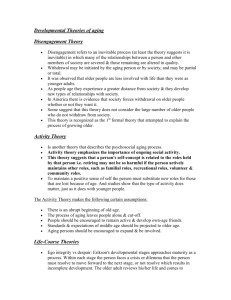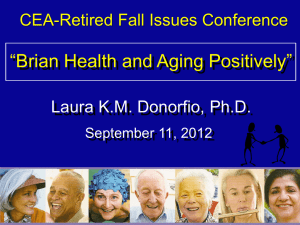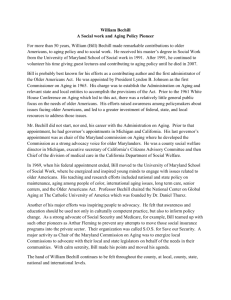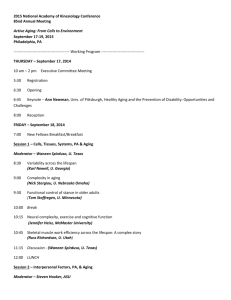Biosketch - University of Washington Pathology
advertisement
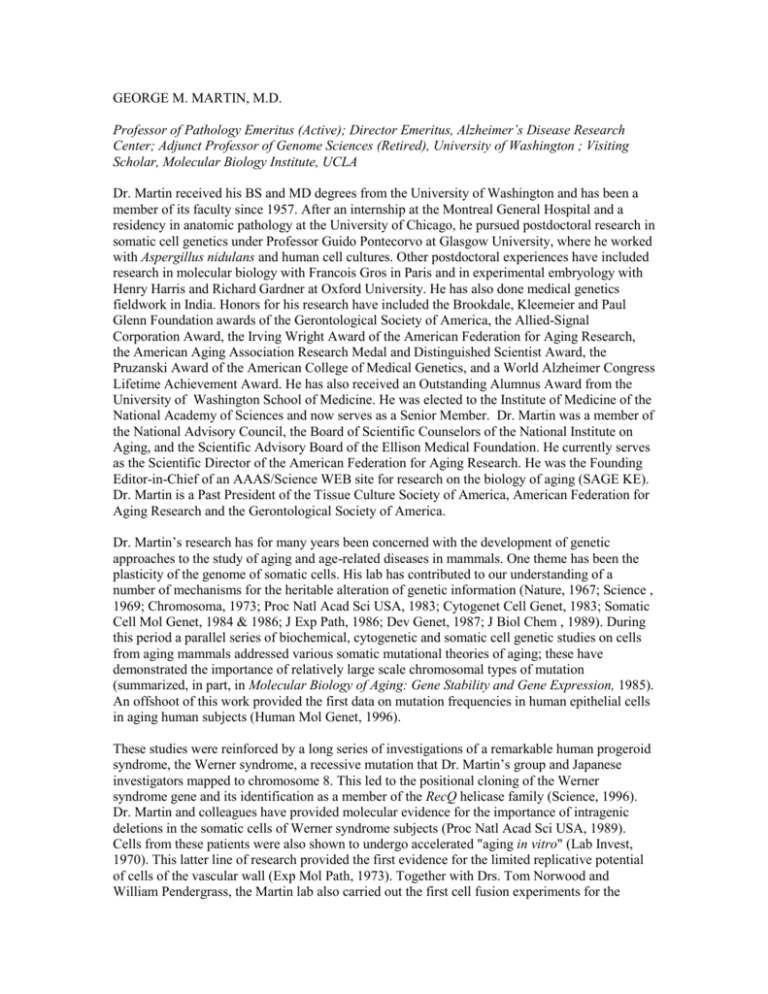
GEORGE M. MARTIN, M.D. Professor of Pathology Emeritus (Active); Director Emeritus, Alzheimer’s Disease Research Center; Adjunct Professor of Genome Sciences (Retired), University of Washington ; Visiting Scholar, Molecular Biology Institute, UCLA Dr. Martin received his BS and MD degrees from the University of Washington and has been a member of its faculty since 1957. After an internship at the Montreal General Hospital and a residency in anatomic pathology at the University of Chicago, he pursued postdoctoral research in somatic cell genetics under Professor Guido Pontecorvo at Glasgow University, where he worked with Aspergillus nidulans and human cell cultures. Other postdoctoral experiences have included research in molecular biology with Francois Gros in Paris and in experimental embryology with Henry Harris and Richard Gardner at Oxford University. He has also done medical genetics fieldwork in India. Honors for his research have included the Brookdale, Kleemeier and Paul Glenn Foundation awards of the Gerontological Society of America, the Allied-Signal Corporation Award, the Irving Wright Award of the American Federation for Aging Research, the American Aging Association Research Medal and Distinguished Scientist Award, the Pruzanski Award of the American College of Medical Genetics, and a World Alzheimer Congress Lifetime Achievement Award. He has also received an Outstanding Alumnus Award from the University of Washington School of Medicine. He was elected to the Institute of Medicine of the National Academy of Sciences and now serves as a Senior Member. Dr. Martin was a member of the National Advisory Council, the Board of Scientific Counselors of the National Institute on Aging, and the Scientific Advisory Board of the Ellison Medical Foundation. He currently serves as the Scientific Director of the American Federation for Aging Research. He was the Founding Editor-in-Chief of an AAAS/Science WEB site for research on the biology of aging (SAGE KE). Dr. Martin is a Past President of the Tissue Culture Society of America, American Federation for Aging Research and the Gerontological Society of America. Dr. Martin’s research has for many years been concerned with the development of genetic approaches to the study of aging and age-related diseases in mammals. One theme has been the plasticity of the genome of somatic cells. His lab has contributed to our understanding of a number of mechanisms for the heritable alteration of genetic information (Nature, 1967; Science , 1969; Chromosoma, 1973; Proc Natl Acad Sci USA, 1983; Cytogenet Cell Genet, 1983; Somatic Cell Mol Genet, 1984 & 1986; J Exp Path, 1986; Dev Genet, 1987; J Biol Chem , 1989). During this period a parallel series of biochemical, cytogenetic and somatic cell genetic studies on cells from aging mammals addressed various somatic mutational theories of aging; these have demonstrated the importance of relatively large scale chromosomal types of mutation (summarized, in part, in Molecular Biology of Aging: Gene Stability and Gene Expression, 1985). An offshoot of this work provided the first data on mutation frequencies in human epithelial cells in aging human subjects (Human Mol Genet, 1996). These studies were reinforced by a long series of investigations of a remarkable human progeroid syndrome, the Werner syndrome, a recessive mutation that Dr. Martin’s group and Japanese investigators mapped to chromosome 8. This led to the positional cloning of the Werner syndrome gene and its identification as a member of the RecQ helicase family (Science, 1996). Dr. Martin and colleagues have provided molecular evidence for the importance of intragenic deletions in the somatic cells of Werner syndrome subjects (Proc Natl Acad Sci USA, 1989). Cells from these patients were also shown to undergo accelerated "aging in vitro" (Lab Invest, 1970). This latter line of research provided the first evidence for the limited replicative potential of cells of the vascular wall (Exp Mol Path, 1973). Together with Drs. Tom Norwood and William Pendergrass, the Martin lab also carried out the first cell fusion experiments for the investigation of dominance/recessivity relationships between old cells, young cells and "immortal" cells (Proc Natl Acad Sci USA, 1974; J Cell Biol, 1975) and demonstrated that the decline of growth potential involved gradual and variable attenuations of clonal growth (Am J Path, 1974). At a more clinical level, Dr. Martin has systematized our knowledge of human genetic disorders from the point of view of their rich potential to elucidate specific aspects of the senescent phenotype (Birth Defects, 1978) and used this analysis to make inferences concerning the polygenic basis of aging. Later in his career, Dr. Martin turned his attention to mechanisms of the aging of post-replicative cells, again using genetic approaches. He assembled a team of investigators to carry out a linkage analysis of familial Alzheimer disease, an effort that led to the assignment of the commonest form to chromosome 14 (Science, 1992) and to the mapping and positional cloning of a related locus on chromosome 1 (Science, 1995). New candidate genes were sought using the yeast protein interaction trap methodology. This work has led to a series of papers on an adaptor protein (FE65) that is of importance in the modulation of the function of the beta amyloid precursor protein; polymorphisms at that locus were shown to play a role in the susceptibility to Alzheimer disease in very old individuals (Hum Mol Genet, 1996; Hum Genet, 1998; J Neurosci Res, 1999; J Neurosci Res, 2000; Human Mol Genet, 2002; J Neurosci Res, 2004; J Biol Chem, 2005; J Biol Chem, 2006; J Neurochem, 2010). These studies were complemented by attempts to develop cell culture (Biochem Biophys Res Commun, 1992) and transgenic (Exp Neurol, 1994; Amer J Path, 1996) models for the study of Alzheimer disease and the pathobiology of aging, including the synthesis of the first “knock-in” and “conditional “knock-out” transgenic mouse models of human presenilin 1 dysfunction (Nature Med, 1999; Neuron, 2001). The latter study demonstrated an intriguing correlation, in presenilin deficient mice, between diminished hippocampal stem cell replication and aberrations in memory. Evolutionary biological theories of aging have been important components of his research through much of his career (Fed Proc, 1979; Nature Genet, 1996; Neurobiol Aging, 2002; Archiv Neurol, 2002; Exp Gerontol, 2006; Ann NY Acad Sci 2007) and currently occupies most of his attention (Aging Cell, 2009; Molecular Neurodegen, 2012; Mech Ageing and Develop, 2012). Dr. Martin is certified by the American Board of Medical Genetics (Clinical Cytogenetics) and the American Board of Pathology. He has participated in the service functions of the Department of Pathology of the University of Washington since 1957, initially as a surgical pathologist and, for many years, as a cytogeneticist. His major teaching contributions at the University of Washington have involved the founding directorships of the Medical Scientist Training Program and the “Genetic Approaches to Aging Research” Institutional Training Grant of the National Institute on Aging. He continues to serve on the Executive Committee of that program and the Nathan Shock Center of Excellence for Basic Research on the Biology of Aging, both of which are under the directorship of his former graduate student, Professor Peter S. Rabinovitch.

